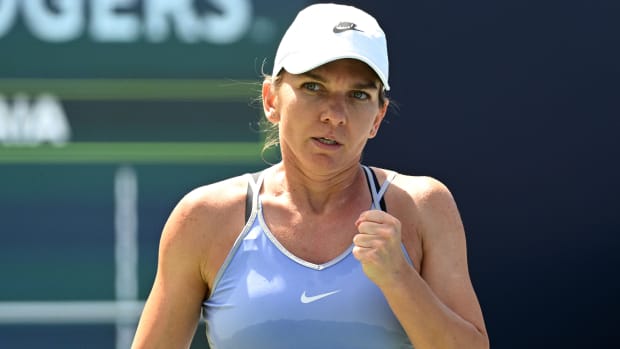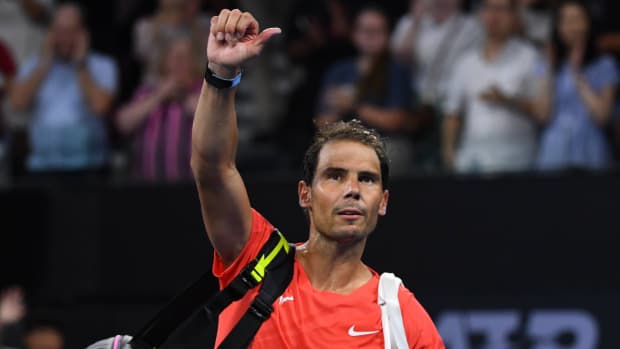‘Battle of the Sexes’ Match Was Tricky to Photograph
Full Frame is Sports Illustrated’s exclusive newsletter for subscribers, highlighting the stories and personalities behind some of SI’s photography every other week.
To get the best of SI in your inbox every weekday, sign up here. To see even more from SI’s photographers, follow @sifullframe on Instagram. If you missed our story on Mo’Ne Davis at the Little League World Series, you can find it here.
On the evening of Sept. 20, 1973, more than 30,400 spectators filled the Houston Astrodome to watch a must-see event: 29-year-old Billie Jean King vs. 55-year-old Bobby Riggs in a tennis spectacle dubbed The Battle of the Sexes. The internationally televised exhibition match wasn’t the first of its kind that year—Riggs, the former World No. 1, had challenged Margaret Court only four months earlier, winning quickly in straight sets in front of a crowd of only 5,000—but it garnered much more fanfare.
“This event was like none other before,” says longtime Sports Illustrated photographer Neil Leifer. “Nobody had ever held a tennis match in a stadium like this. It was a Hollywood production.
“But I don't remember an iconic photograph coming out of that match—and yet it was an iconic match.”
Indeed, this was the first (and last) tennis match to be held in the stadium known as “The Eighth Wonder of the World,” a heavily-promoted duel between man and woman. Leifer says he considers the Astrodome his “lucky stadium,” because it was there that he shot his favorite picture ever—and perhaps one of the most iconic in sports. “My photos of Cleveland Williams and Muhammad Ali [in November 1966], looking straight down to the ring, was taken there, with strobe lights,” Leifer says. “So I knew the arena very well.”
But despite the allure and pageantry surrounding the Battle of the Sexes, it was an unusual sporting event—for both the spectators and photographers like Leifer. For one, there were no strobe lights being used on the court or in the stadium, as there were for the Ali vs. Williams bout. “The lighting in the Astrodome was lousy,” says Leifer. “The natural light was great for television, but it was not good for the quality of the still images.”
Even more peculiar was the logistical set-up of the tennis court in the middle of the baseball field, in an Astrodome filled to half capacity. As illustrated in one of the Leifer’s photos from the event, the entire stadium behind home plate was completely empty, with spectators filling only one side, near where the court was created.
“It was a great crowd, but many of them were nowhere near the court,” Leifer says. “It was almost like two different events. There were spectators that were lucky enough to sit like you would in a normal tennis match, right alongside the court. But then there was no one else going all the way back to the stands.”
Leifer says this created an odd environment in the stadium whenever the crowd cheered for a King winner or a Riggs’ ace.
“It was like this isolated court,” Leifer says. “I can't articulate it exactly, but there was a strange feeling in the place because you had two different sounds—one was the courtside fans, which is what you’re used to hearing. And the other was the cheers from the fans farther back.”
Despite it all, the match was a brilliant success. In addition to the audience in Houston, an estimated 50 million people in the U.S. and 90 million worldwide viewed the event on TV. And even more notably, King defeated Riggs in three sets, marking a pivotal moment for women’s sports and one of many personal milestones in the Hall of Famer’s fight for equality, which continues today.
For Leifer—a celebrated photographer with countless renowned pictures in his archive—he says the memorable event did not yield any memorable images for his collection. But he was still able to capture unique moments in time, from Riggs’ Sugar Daddy ensemble and memorabilia; to the birds-eye view of the court dropped in the middle of a baseball field; to King’s feather-trimmed throne and victory parade around the stadium.
“Photographers are just like the athletes—sometimes you have a good night, sometimes you don’t,” Leifer says. “The whole thing was entertainment. I don’t know for sure, but I have a feeling that Billie Jean just had a good time. I think Billie Jean just enjoyed the hell out of it.”
Have questions, comments, or feedback about Sports Illustrated‘s newsletters? Send a note to josh.rosenblat@si.com.










